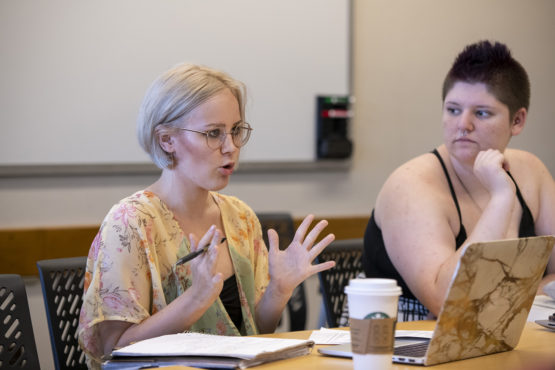New Stanford class examines the literary origins of fantastical creatures
In a new class, called Medieval Fantasy Literature, students examined the origins of dragons, witches and other fantastical creatures by reading a series of ancient works.
Over summer quarter, a group of students visited a fantasy world of trolls, ogres, dragons, witches and fairies in a new Stanford humanities course.

Stanford English doctoral candidate Max Ashton teaches a summer quarter class on the role of dragons, ogres and other creatures in medieval literature. (Image credit: L.A. Cicero)
Fantastical creatures inhabit many of today’s popular novels, films and TV series, but their origins date to texts over 1,000 years old. These ancient works of art, whose original authors are mostly unknown, were the focus of the Medieval Fantasy Literature course taught by Stanford English doctoral candidate Max Ashton.
“Today, fantasy is often seen as low culture meant to entertain, not to enlighten – to distract, not to engage,” Ashton said. “Medieval people, on the other hand, saw the fantastic and the marvelous as natural subjects of the most dignified literature.”
During the eight-week course, students read some of the oldest European medieval fantasy stories, including 10th-century Old English epic poem Beowulf as well as old Celtic and Norse texts like The Mabinogion and The Elder Edda. They also read modern works for comparison, including The Lord of the Rings, first published in 1954.
Artistic fruits of medieval people
Ashton’s inspiration for a course about the roots of modern fantasy literature arose from his PhD thesis, which is about violence and its representation in medieval texts.
“Medievalism is very much alive today the way it has been for centuries,” Ashton said. “Cultural phenomena like Game of Thrones, The Lord of the Rings, the Harry Potter series and other young adult literature have been inspired by old medieval texts. So I thought students would be interested to see where the inception of the stories they love today started.”
Medieval fantasy works were popular during their time just as contemporary fantasy stories are today, Ashton said.

Claire Francis, left, and Kyle Ostrum discuss fantastic creatures during their Medieval Fantasy Literature class. (Image credit: L.A. Cicero)
One example of the old inspiring the new is Beowulf, which is one of the oldest works of literature that contains a description of a fire-breathing dragon, he said. The Old English poem was a known inspiration to J. R. R. Tolkien, the author of The Lord of the Rings, and contemporary fantasy writers.
Reading old fantasy works can also give today’s readers new perspectives about the present world and humanity’s ongoing issues of violence and other problems.
Medieval authors used their imagination and supernatural creatures to enliven the philosophical and moral themes in their work as well as represent the problems they see in the real world, Ashton said.
For example, in Beowulf, the monster Grendel is described to have come to life after Cain killed his brother Abel, as per the events of the Old Testament book of Genesis. The violence of Grendel is a representation of the sin of murder and betrayal, Ashton said.
“It’s important to examine the fruits of artistic production made under conditions that are widely different from what we know today,” he said.
Rediscovering old fantasy stories
Kyle Ostrum took the class as part of Stanford’s high school summer college. As a junior in a high school in Richmond, Virginia, Ostrum said he was eager to learn about medieval literature, which he hadn’t been exposed to before.
“It was exciting to actually be able to read such an old tale and understand it.”
—Kyle Ostrum
Summer School Student
“I’m really interested in fantasy literature, but in high school you get mostly exposed to only the classics from the 18th and 19th century,” Ostrum said. “So it’s been exciting to read some of the old Norse and Icelandic tales, elements of which are still present in today’s fantasy stories.”
Ostrum said he especially enjoyed reading The Saga of King Hrolf Kraki, a 13th-century Icelandic tale about the adventures of a Danish king and his family.
“It was exciting to actually be able to read such an old tale and understand it,” Ostrum said. “The tale’s narrative was pretty straightforward, and I wasn’t expecting that. After I read it, I felt really accomplished.”
Stanford English senior Claire Francis took the class because she has been a long-time fan of fantasy literature, including the work of authors such as contemporary writer Neil Gaiman, whose book on Norse mythology they also studied during the class alongside a selection of old Norse stories.
Francis said she likes the fantasy genre because of its ability to highlight complicated social problems and obstacles. She said her favorite work that she and other students had to read for class is The Buried Giant, a 2015 novel by British author Kazuo Ishiguro. The story’s protagonists are part of a group experiencing massive amnesia due to a strange, powerful mist. The work is a commentary about how societies tend to forget traumatic events in history. Francis said the novel is especially relevant to today’s polarized political climate.
Francis said she also enjoyed reading Sir Orfeo, a Middle English narrative poem. The medieval work is a retelling of the classic story of Orpheus, first told by ancient Roman poet Virgil. In the retelling, Orpheus is a king who has to rescue his wife from the evil fairy king.
“I think there is a popular perception that the medieval times descended into the dark ages, which suggests that there was no cultural creation or self-awareness in any of these societies,” Francis said. “That’s just not true. The stories they told say a lot about what they valued, and we can still find something relatable in them that could help us reflect on the problems we still have in our societies today.”
